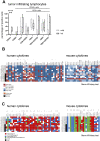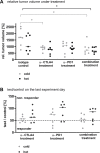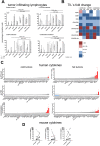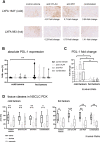Immune cell infiltration pattern in non-small cell lung cancer PDX models is a model immanent feature and correlates with a distinct molecular and phenotypic make-up
- PMID: 35483746
- PMCID: PMC9052060
- DOI: 10.1136/jitc-2021-004412
Immune cell infiltration pattern in non-small cell lung cancer PDX models is a model immanent feature and correlates with a distinct molecular and phenotypic make-up
Abstract
Background: The field of cancer immunology is rapidly moving towards innovative therapeutic strategies, resulting in the need for robust and predictive preclinical platforms reflecting the immunological response to cancer. Well characterized preclinical models are essential for the development of predictive biomarkers in the oncology as well as the immune-oncology space. In the current study, gold standard preclinical models are being refined and combined with novel image analysis tools to meet those requirements.
Methods: A panel of 14 non-small cell lung cancer patient-derived xenograft models (NSCLC PDX) was propagated in humanized NOD/Shi-scid/IL-2Rnull mice. The models were comprehensively characterized for relevant phenotypic and molecular features, including flow cytometry, immunohistochemistry, histology, whole exome sequencing and cytokine secretion.
Results: Models reflecting hot (>5% tumor-infiltrating lymphocytes/TILs) as opposed to cold tumors (<5% TILs) significantly differed regarding their cytokine profiles, molecular genetic aberrations, stroma content, and programmed cell death ligand-1 status. Treatment experiments including anti cytotoxic T-lymphocyte-associated protein 4, anti-programmed cell death 1 or the combination thereof across all 14 models in the single mouse trial format showed distinctive tumor growth response and spatial immune cell patterns as monitored by computerized analysis of digitized whole-slide images. Image analysis provided for the first time qualitative evaluation of the extent to which PDX models retain the histological features from their original human donors.
Conclusions: Deep phenotyping of PDX models in a humanized setting by combinations of computational pathology, immunohistochemistry, flow cytometry and proteomics enables the exhaustive analysis of innovative preclinical models and paves the way towards the development of translational biomarkers for immuno-oncology drugs.
Keywords: biomarkers, tumor; immunohistochemistry; lung neoplasms; tumor microenvironment.
© Author(s) (or their employer(s)) 2022. Re-use permitted under CC BY-NC. No commercial re-use. See rights and permissions. Published by BMJ.
Conflict of interest statement
Competing interests: None declared.
Figures







Similar articles
-
Patient-derived non-small cell lung cancer xenograft mirrors complex tumor heterogeneity.Cancer Biol Med. 2021 Feb 15;18(1):184-198. doi: 10.20892/j.issn.2095-3941.2020.0012. Cancer Biol Med. 2021. PMID: 33628593 Free PMC article.
-
Organoid Cultures as Preclinical Models of Non-Small Cell Lung Cancer.Clin Cancer Res. 2020 Mar 1;26(5):1162-1174. doi: 10.1158/1078-0432.CCR-19-1376. Epub 2019 Nov 6. Clin Cancer Res. 2020. PMID: 31694835
-
Personalizing non-small cell lung cancer treatment through patient-derived xenograft models: preclinical and clinical factors for consideration.Clin Transl Oncol. 2024 Sep;26(9):2227-2239. doi: 10.1007/s12094-024-03450-3. Epub 2024 Mar 29. Clin Transl Oncol. 2024. PMID: 38553659 Free PMC article.
-
Immunotherapy in NSCLC patients with brain metastases. Understanding brain tumor microenvironment and dissecting outcomes from immune checkpoint blockade in the clinic.Cancer Treat Rev. 2020 Sep;89:102067. doi: 10.1016/j.ctrv.2020.102067. Epub 2020 Jul 7. Cancer Treat Rev. 2020. PMID: 32682248 Review.
-
Current status and perspectives of patient-derived xenograft models in cancer research.J Hematol Oncol. 2017 May 12;10(1):106. doi: 10.1186/s13045-017-0470-7. J Hematol Oncol. 2017. PMID: 28499452 Free PMC article. Review.
Cited by
-
Humanized Mouse Models for Immuno-Oncology Research: A Review and Implications in Lung Cancer Research.JTO Clin Res Rep. 2024 Dec 18;6(3):100781. doi: 10.1016/j.jtocrr.2024.100781. eCollection 2025 Mar. JTO Clin Res Rep. 2024. PMID: 39990135 Free PMC article. Review.
-
Endothelial OX40 activation facilitates tumor cell escape from T cell surveillance through S1P/YAP-mediated angiogenesis.J Clin Invest. 2025 Mar 3;135(5):e186291. doi: 10.1172/JCI186291. J Clin Invest. 2025. PMID: 40026246 Free PMC article.
-
Deconer: An Evaluation Toolkit for Reference-based Deconvolution Methods Using Gene Expression Data.Genomics Proteomics Bioinformatics. 2025 May 10;23(1):qzaf009. doi: 10.1093/gpbjnl/qzaf009. Genomics Proteomics Bioinformatics. 2025. PMID: 39963994 Free PMC article.
-
Testing Cancer Immunotherapeutics in a Humanized Mouse Model Bearing Human Tumors.J Vis Exp. 2022 Dec 16;(190):10.3791/64606. doi: 10.3791/64606. J Vis Exp. 2022. PMID: 36591990 Free PMC article.
-
Transcriptomic, Proteomic, and Genomic Mutational Fraction Differences Based on HPV Status Observed in Patient-Derived Xenograft Models of Penile Squamous Cell Carcinoma.Cancers (Basel). 2024 Mar 6;16(5):1066. doi: 10.3390/cancers16051066. Cancers (Basel). 2024. PMID: 38473423 Free PMC article.
References
-
- Bertotti A, Migliardi G, Galimi F, et al. . A molecularly annotated platform of patient-derived xenografts ("xenopatients") identifies HER2 as an effective therapeutic target in cetuximab-resistant colorectal cancer. Cancer Discov 2011;1:508–23. 10.1158/2159-8290.CD-11-0109 - DOI - PubMed
Publication types
MeSH terms
Substances
LinkOut - more resources
Full Text Sources
Medical
